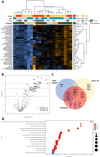Transcriptomic Differences in Medullary Thyroid Carcinoma According to Grade
- PMID: 38958823
- PMCID: PMC11387449
- DOI: 10.1007/s12022-024-09817-0
Transcriptomic Differences in Medullary Thyroid Carcinoma According to Grade
Abstract
Medullary thyroid carcinoma (MTC) is a rare cancer derived from neuroendocrine C-cells of the thyroid. In contrast to other neuroendocrine tumors, a histological grading system was lacking until recently. A novel two-tier grading system based on the presence of high proliferation or necrosis is associated with prognosis. Transcriptomic analysis was conducted on 21 MTCs, including 9 high-grade tumors, with known mutational status, using the NanoString Tumor Signaling 360 Panel. This analysis, covering 760 genes, revealed upregulation of the genes EGLN3, EXO1, UBE2T, UBE2C, FOXM1, CENPA, DLL3, CCNA2, SOX2, KIF23, and CDCA5 in high-grade MTCs. Major pathways differentially expressed between high-grade and low-grade MTCs were DNA damage repair, p53 signaling, cell cycle, apoptosis, and Myc signaling. Validation through qRT-PCR in 30 MTCs demonstrated upregulation of ASCL1, DLL3, and SOX2 in high-grade MTCs, a gene signature akin to small-cell lung carcinoma, molecular subgroup A. Subsequently, DLL3 expression was validated by immunohistochemistry. MTCs with DLL3 overexpression (defined as ≥ 50% of positive tumor cells) were associated with significantly lower disease-free survival (p = 0.041) and overall survival (p = 0.01). Moreover, MTCs with desmoplasia had a significantly increased expression of DLL3. Our data supports the idea that DLL3 should be further explored as a predictor of aggressive disease and poor outcomes in MTC.
Keywords: DLL3; Endocrine pathology; Medullary thyroid carcinoma; Neuroendocrine neoplasia; Thyroid; Transcriptomic.
© 2024. The Author(s).
Conflict of interest statement
Ignacio Ruz-Caracuel has received lecture fees and travel reimbursement from Lilly. Teresa Alonso-Gordoa has received research funding, honoraria, and nonfinancial support from IPSEN, Adacap, Pfizer, Sanofi, EISAI, Lilly, Bayer, Janssen, BMS, Astellas, Novartis, Roche, MSD. Javier Molina-Cerrillo has received research funding, honoraria, and nonfinancial support from IPSEN, Adacap, Pfizer, Sanofi, EISAI, Janssen, BMS, Astellas, Roche, and MSD.
Figures




References
-
- Le MK, Kawai M, Odate T, Vuong HG, Oishi N, Kondo T (2022) Metastatic Risk Stratification of 2526 Medullary Thyroid Carcinoma Patients: A Study Based on Surveillance, Epidemiology, and End Results Database Endocr Pathol 33:348-358. 10.1007/s12022-022-09724-2 10.1007/s12022-022-09724-2 - DOI - PubMed
-
- Xu B, Fuchs TL, Ahmadi S, Alghamdi M, Alzumaili B, Bani MA, Baudin E, Chou A, De Leo A, Fagin JA, Ganly I, Glover A, Hartl D, Kanaan C, Khneisser P, Najdawi F, Nigam A, Papachristos A, Repaci A, Spanheimer PM, Solaroli E, Untch BR, Barletta JA, Tallini G, Al Ghuzlan A, Gill AJ, Ghossein RA (2022) International Medullary Thyroid Carcinoma Grading System: A Validated Grading System for Medullary Thyroid Carcinoma J Clin Oncol 40:96-104. 10.1200/JCO.21.01329 10.1200/JCO.21.01329 - DOI - PMC - PubMed
-
- Vissio E, Maletta F, Fissore J, Osella Abate S, Retta F, Brizzi MP, Piovesan A, Rossetto Giaccherino R, Volante M, Papotti M (2022) External Validation of Three Available Grading Systems for Medullary Thyroid Carcinoma in a Single Institution Cohort Endocr Pathol 33:359-370. 10.1007/s12022-022-09719-z 10.1007/s12022-022-09719-z - DOI - PubMed
MeSH terms
Substances
Supplementary concepts
Grants and funding
LinkOut - more resources
Full Text Sources
Medical
Research Materials
Miscellaneous

